The Virtual Prototype Market is estimated to be valued at USD 778.8 million in 2025 and is projected to reach USD 2938.4 million by 2035, registering a compound annual growth rate (CAGR) of 14.2% over the forecast period.
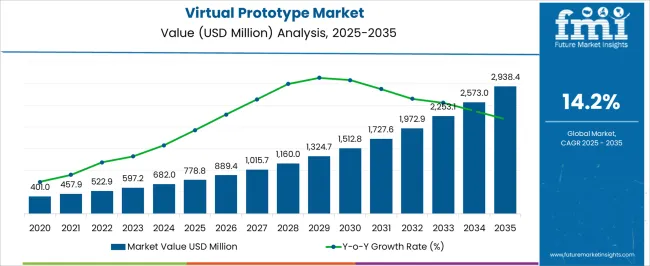
| Metric | Value |
|---|---|
| Virtual Prototype Market Estimated Value in (2025 E) | USD 778.8 million |
| Virtual Prototype Market Forecast Value in (2035 F) | USD 2938.4 million |
| Forecast CAGR (2025 to 2035) | 14.2% |
The virtual prototype market is witnessing strong growth, driven by the increasing need to accelerate product development cycles and reduce costs associated with physical prototyping. Rising complexity in product design across industries such as automotive, aerospace, and electronics is pushing organizations to adopt advanced simulation-based approaches. Virtual prototyping tools enable engineers to evaluate performance, durability, and safety under real-world conditions through digital models, which enhances accuracy and reduces the number of physical tests required.
The integration of artificial intelligence and machine learning into simulation platforms is further improving predictive capabilities, helping companies shorten time-to-market. The adoption of cloud and host-based deployment models is expanding accessibility by providing scalable computational resources, lowering upfront costs, and enabling real-time collaboration across global teams.
Regulatory pressure to ensure higher product safety and efficiency is also creating favorable conditions for wider adoption As digital transformation continues to accelerate, virtual prototyping is becoming a central part of innovation strategies, positioning the market for significant long-term expansion with growing applications across multiple industries.
The virtual prototype market is segmented by type of virtual prototyping tool, deployment type, end user industry, and geographic regions. By type of virtual prototyping tool, virtual prototype market is divided into Finite Element Analysis (FEA), Computational Fluid Dynamic (CFD), and Computer Aided Machining (CAM). In terms of deployment type, virtual prototype market is classified into Cloud/Host and On-Premises. Based on end user industry, virtual prototype market is segmented into Automotive, Aerospace, Petroleum, Chemical, Government or Military, Healthcare, Telecommunications, Electronics, and Entertainment. Regionally, the virtual prototype industry is classified into North America, Latin America, Western Europe, Eastern Europe, Balkan & Baltic Countries, Russia & Belarus, Central Asia, East Asia, South Asia & Pacific, and the Middle East & Africa.
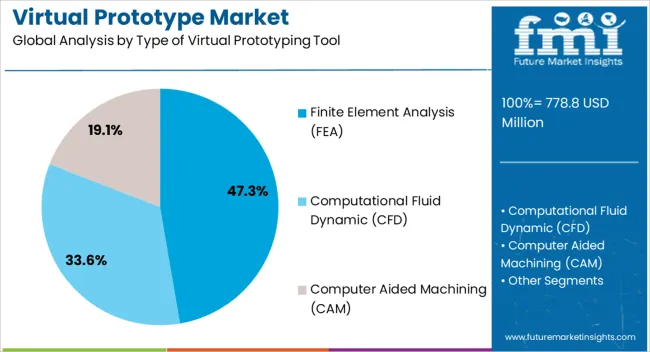
The finite element analysis tool segment is expected to hold 47.3% of the virtual prototype market revenue share in 2025, making it the leading type of virtual prototyping tool. Its dominance is being driven by the critical role it plays in analyzing structural, thermal, and fluid dynamics performance across complex product designs. By dividing models into smaller finite elements, this tool allows engineers to simulate stress distribution, deformation, and failure points with high accuracy, ensuring product reliability before physical production.
The segment is experiencing strong adoption across industries where precision and safety are paramount, particularly in high-value engineering applications. Advances in computing power and algorithm efficiency are enabling more complex models to be analyzed quickly, further improving development speed.
The ability of finite element analysis tools to reduce costs associated with physical testing while ensuring compliance with safety and performance standards is reinforcing their adoption As products become increasingly complex, the demand for this segment is expected to grow, maintaining its leadership in the overall market.
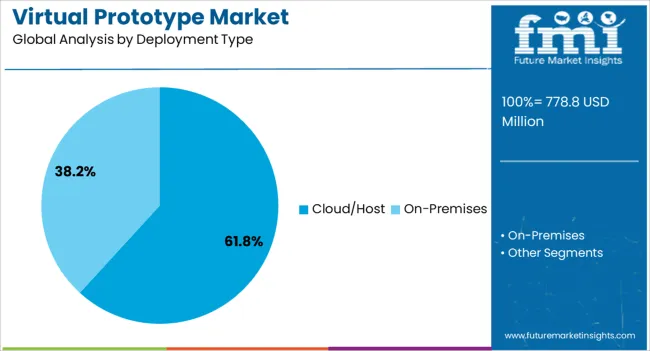
The cloud or host deployment segment is projected to capture 61.8% of the virtual prototype market revenue share in 2025, establishing itself as the dominant deployment model. Its leadership is being supported by the flexibility, scalability, and cost-efficiency it provides to organizations of varying sizes. Cloud-based platforms allow engineers and designers to access high-performance computing resources without investing in expensive on-premises infrastructure.
This capability is especially important for analyzing large and complex simulations that require extensive computational power. Real-time collaboration across geographically dispersed teams is also being enabled by cloud deployment, enhancing productivity and accelerating decision-making in product development cycles.
The pay-as-you-go model of cloud services is lowering barriers to entry, encouraging adoption by small and medium enterprises alongside larger corporations As enterprises continue to pursue digital transformation strategies, the scalability and efficiency of cloud deployment models are expected to solidify their dominance in the market, with continuous improvements in cybersecurity and data management further supporting growth.
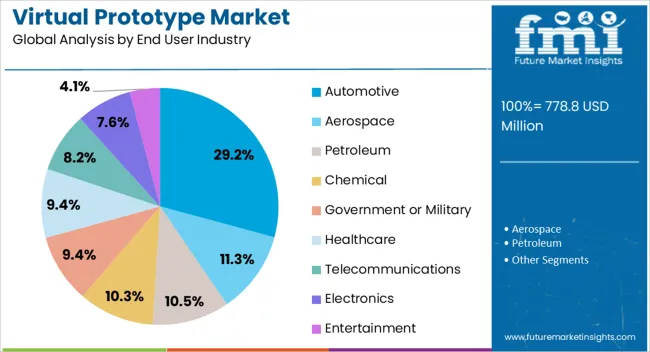
The automotive end user industry segment is anticipated to represent 29.2% of the virtual prototype market revenue share in 2025, making it the leading industry vertical. Its dominance is being explained by the growing need to address increasing complexity in vehicle design, driven by the rise of electric vehicles, autonomous driving technologies, and stricter emission and safety standards. Virtual prototyping in the automotive sector enables the testing of multiple systems, including structural integrity, aerodynamics, thermal management, and electronics integration, all within a digital environment.
This capability significantly reduces development time while ensuring compliance with regulatory requirements and safety benchmarks. The cost savings achieved by minimizing physical prototypes are particularly valuable in the highly competitive automotive sector, where faster time-to-market provides a distinct advantage.
The segment is also benefiting from the integration of advanced driver-assistance systems and smart mobility solutions, which require extensive validation through simulation With automotive companies increasing investments in digital engineering tools, this segment is expected to sustain its leadership in the virtual prototype market.
Today the product development environment often revolves around compressed schedules and budget cuts, but an engineer must skillfully weave between these obstacles to reach his ultimate goal – Product release. One revolutionary method aiding the process of product development is Virtual Prototyping.
A virtual prototype is a digital simulation of a physical product that can be used to visualize its behavior under real-world operating conditions. The designing and testing of a virtual prototype is called virtual prototyping.
A typical virtual prototyping solution involves, creation of a 3D solid model, a human-product interaction model and different test related models for structural analysis, motion analysis and manufacturing evaluations.
The process involves usage of variegated advance softwares such as computer-automated design (CAutoD), computer-aided design (CAD), computer-aided engineering (CAE) etc. to present, analyze and test the various aspects of product life cycle.
The prime advantage of virtual prototyping is a significant reduction in “time-to-market”. The process of creating a novel product involved numerous prototype builds, testing and the investment of months to years.
However with the current availability of multi-physics modeling softwares for virtual prototyping, the time and investment is considerably reduced. Secondly, building and testing on a physical prototype can miss some problems that may not materialize in test chambers, as manufactured.
Whereas, in virtual prototyping such corner errors can be pointed out and hence improving on design quality. Thirdly, as it creates prototypes pretty quickly, the method empowers the user to test with multiple complex designs and helps in developing a more competitive product within a limited time frame.
Owing to these lucrative advantages the global virtual prototype market is anticipated to witness a healthy CAGR during the forecast period.
Growing competitiveness among all players of manufacturing industry, urges the use of virtual prototyping in their product development, as it helps businesses minimize time and cost while maximizing on quality and efficiency.
Parallely the continuous growth in aerospace and automotive industry, is driving the need for new product development which in turn also fuels the market for virtual prototype.
On the other hand, small player might restrain from virtual prototype solutions at this point of time due to high initial investment and lack of skilled professionals.
Geographically, the global virtual prototype marketcan be divided into seven regions, namely North America, Latin America, Western Europe, Eastern Europe, Asia Pacific Excluding Japan (APEJ), Japan and the Middle East and Africa (MEA). Currently, North America and Europe owns the majority share in the virtual prototype solutions market, owing to high technology adoption in their local manufacturing sector.
The APEJ nations particularly China and India, are anticipated to show a significant growth in their automobile and aerospace sectors in the forecast period, concurrently increasing their share in the global market for virtual prototypes.
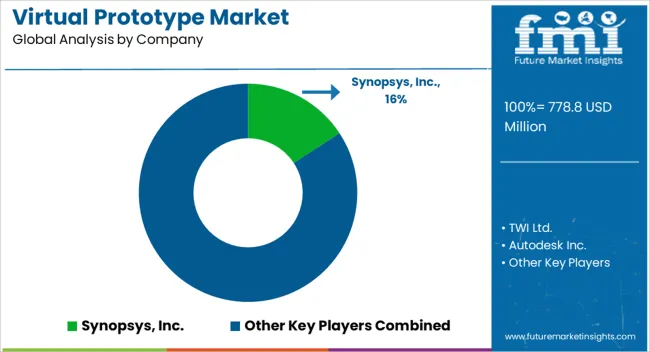
AutoDesk, ARM, Imperas, Coverity, Carbon Design Systems, Synopsys, Qualcomm, Nvidia, Mentor Graphics, MediaTek, ASTC, Imagination Technologies, Cadence, ESI Group, Agilent Technologies etc.
The research report presents a comprehensive assessment of the market and contains thoughtful insights, facts, historical data, and statistically supported and industry-validated market data.
It also contains projections using a suitable set of assumptions and methodologies. The research report provides analysis and information according to market segments such as geographies, and applications.
The report is a compilation of first-hand information, qualitative and quantitative assessment by industry analysts, inputs from industry experts and industry participants across the value chain. The report provides in-depth analysis of parent market trends, macro-economic indicators and governing factors along with market attractiveness as per segments. The report also maps the qualitative impact of various market factors on market segments and geographies.
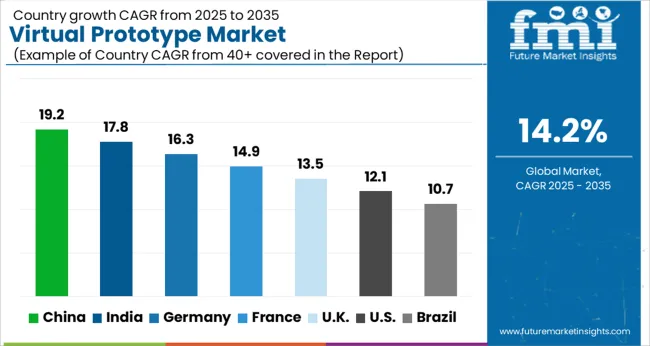
| Country | CAGR |
|---|---|
| China | 19.2% |
| India | 17.8% |
| Germany | 16.3% |
| France | 14.9% |
| UK | 13.5% |
| USA | 12.1% |
| Brazil | 10.7% |
The Virtual Prototype Market is expected to register a CAGR of 14.2% during the forecast period, exhibiting varied country level momentum. China leads with the highest CAGR of 19.2%, followed by India at 17.8%. Developed markets such as Germany, France, and the UK continue to expand steadily, while the USA is likely to grow at consistent rates. Brazil posts the lowest CAGR at 10.7%, yet still underscores a broadly positive trajectory for the global Virtual Prototype Market. In 2024, Germany held a dominant revenue in the Western Europe market and is expected to grow with a CAGR of 16.3%. The USA Virtual Prototype Market is estimated to be valued at USD 286.8 million in 2025 and is anticipated to reach a valuation of USD 896.5 million by 2035. Sales are projected to rise at a CAGR of 12.1% over the forecast period between 2025 and 2035. While Japan and South Korea markets are estimated to be valued at USD 35.6 million and USD 27.2 million respectively in 2025.
| Item | Value |
|---|---|
| Quantitative Units | USD 778.8 Million |
| Type of Virtual Prototyping Tool | Finite Element Analysis (FEA), Computational Fluid Dynamic (CFD), and Computer Aided Machining (CAM) |
| Deployment Type | Cloud/Host and On-Premises |
| End User Industry | Automotive, Aerospace, Petroleum, Chemical, Government or Military, Healthcare, Telecommunications, Electronics, and Entertainment |
| Regions Covered | North America, Europe, Asia-Pacific, Latin America, Middle East & Africa |
| Country Covered | United States, Canada, Germany, France, United Kingdom, China, Japan, India, Brazil, South Africa |
| Key Companies Profiled | Synopsys, Inc., TWI Ltd., Autodesk Inc., Carbon Design System, ESI Group, Arm Limited, Cadence Design Systems, Inc., Siemens, PTC, and ENCORE |
The global virtual prototype market is estimated to be valued at USD 778.8 million in 2025.
The market size for the virtual prototype market is projected to reach USD 2,938.4 million by 2035.
The virtual prototype market is expected to grow at a 14.2% CAGR between 2025 and 2035.
The key product types in virtual prototype market are finite element analysis (fea), computational fluid dynamic (cfd) and computer aided machining (cam).
In terms of deployment type, cloud/host segment to command 61.8% share in the virtual prototype market in 2025.






Our Research Products

The "Full Research Suite" delivers actionable market intel, deep dives on markets or technologies, so clients act faster, cut risk, and unlock growth.

The Leaderboard benchmarks and ranks top vendors, classifying them as Established Leaders, Leading Challengers, or Disruptors & Challengers.

Locates where complements amplify value and substitutes erode it, forecasting net impact by horizon

We deliver granular, decision-grade intel: market sizing, 5-year forecasts, pricing, adoption, usage, revenue, and operational KPIs—plus competitor tracking, regulation, and value chains—across 60 countries broadly.

Spot the shifts before they hit your P&L. We track inflection points, adoption curves, pricing moves, and ecosystem plays to show where demand is heading, why it is changing, and what to do next across high-growth markets and disruptive tech

Real-time reads of user behavior. We track shifting priorities, perceptions of today’s and next-gen services, and provider experience, then pace how fast tech moves from trial to adoption, blending buyer, consumer, and channel inputs with social signals (#WhySwitch, #UX).

Partner with our analyst team to build a custom report designed around your business priorities. From analysing market trends to assessing competitors or crafting bespoke datasets, we tailor insights to your needs.
Supplier Intelligence
Discovery & Profiling
Capacity & Footprint
Performance & Risk
Compliance & Governance
Commercial Readiness
Who Supplies Whom
Scorecards & Shortlists
Playbooks & Docs
Category Intelligence
Definition & Scope
Demand & Use Cases
Cost Drivers
Market Structure
Supply Chain Map
Trade & Policy
Operating Norms
Deliverables
Buyer Intelligence
Account Basics
Spend & Scope
Procurement Model
Vendor Requirements
Terms & Policies
Entry Strategy
Pain Points & Triggers
Outputs
Pricing Analysis
Benchmarks
Trends
Should-Cost
Indexation
Landed Cost
Commercial Terms
Deliverables
Brand Analysis
Positioning & Value Prop
Share & Presence
Customer Evidence
Go-to-Market
Digital & Reputation
Compliance & Trust
KPIs & Gaps
Outputs
Full Research Suite comprises of:
Market outlook & trends analysis
Interviews & case studies
Strategic recommendations
Vendor profiles & capabilities analysis
5-year forecasts
8 regions and 60+ country-level data splits
Market segment data splits
12 months of continuous data updates
DELIVERED AS:
PDF EXCEL ONLINE
Virtual Land NFT Market Size and Share Forecast Outlook 2025 to 2035
Virtual Pipeline Market Size and Share Forecast Outlook 2025 to 2035
Virtual Customer Premises Equipment Market Size and Share Forecast Outlook 2025 to 2035
Virtual Infrastructure Manager Market Size and Share Forecast Outlook 2025 to 2035
Virtual Companion Care Market Size and Share Forecast Outlook 2025 to 2035
Virtualized Radio Access Network Market Size and Share Forecast Outlook 2025 to 2035
Virtual Workspace Solutions Market Size and Share Forecast Outlook 2025 to 2035
Virtual Assistant Services Market Size and Share Forecast Outlook 2025 to 2035
Virtual Power Plant (VPP) and V2G Orchestration Market Analysis - Size, Share, and Forecast Outlook 2025 to 2035
Virtual Power Plant Market Size and Share Forecast Outlook 2025 to 2035
Virtual Machines Market by Type, by Enterprise Size, by Industry & Region Forecast till 2035
Virtual Extensible LAN (VXLAN) Market Size and Share Forecast Outlook 2025 to 2035
Virtual Private Cloud Market Size and Share Forecast Outlook 2025 to 2035
Virtual PLC and Soft PLC Market Size and Share Forecast Outlook 2025 to 2035
Virtual Private Network VPN Market Size and Share Forecast Outlook 2025 to 2035
Virtualized Evolved Packet Core (vEPC) Market Size and Share Forecast Outlook 2025 to 2035
Virtual Cards Market Size and Share Forecast Outlook 2025 to 2035
Virtual Try-On Platform Market Analysis Size and Share Forecast Outlook 2025 to 2035
Virtual Private Server Market Size and Share Forecast Outlook 2025 to 2035
Virtual Client Computing Market Size and Share Forecast Outlook 2025 to 2035

Thank you!
You will receive an email from our Business Development Manager. Please be sure to check your SPAM/JUNK folder too.
Chat With
MaRIA